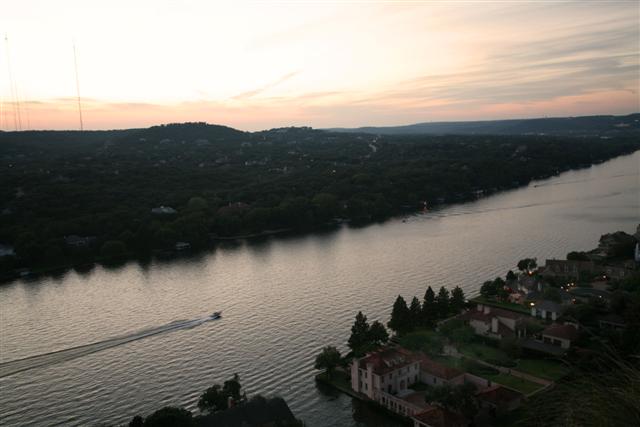Mt. Bonnell Park, site of a Texas Historical Marker, (3800 Mount Bonnell Road) offers one of the best lookout points publicly accessible in Austin, 775′ above the eastern bank of the Colorado river (known as Lake Austin). The park is 1 mile past W. 35th street on the top of Mt. Bonnell Road (also accessible by 2222). There is usually ample parking at the base, but be careful about leaving valuables in the car–the parking lot does have a reputation for car break-ins.
 The summit of Mt. Bonnell is 190′ about the parking lot–102 steps will take you most of the way to the top. The stairs are paved and have a nice handrail; it is an easy climb. If you don’t like steps, you can also get to the top by using a gravel pathway.
The summit of Mt. Bonnell is 190′ about the parking lot–102 steps will take you most of the way to the top. The stairs are paved and have a nice handrail; it is an easy climb. If you don’t like steps, you can also get to the top by using a gravel pathway.
From the top you can see the city to your back (ok if you’re short you might have to hop up on the picnic table), Tom Miller Dam (near Hula Hut) on the left, and 360 bridge on the right. The park has 5 picnic tables so if you get there early you can have a nice picnic as the sun sets or just enjoy the breeze.
Dry Creek Saloon, one of Austin’s legendary bars, is close by on Mount Bonnell Road. Mayfield Park (with peacocks) and Laguna Gloria are on 35th street.
Mt. Bonnell Texas Historical Marker
Year Dedicated: 1969
Information provided by Atomic Axis’ Texas Historical Markers App
Mount Bonnell – Rising 775 feet above sea level, this limestone height was named for George W. Bonnell, who came to Texas with others to fight for Texas independence, 1836. Was commissioner of Indian Affairs in Republic of Texas under president Sam Houston. Moved in 1839 to Austin; there published the “Texas Sentinel”, 1840. Member Texan-Santa Fe expedition, 1841. Was captured but released in time to join Mier expedition, 1842. Was killed in camp on Rio Grande, Dec, 26, 1842. Frontiersman W.A.A. “Bigfoot” Wallace killed an indian he met face to face while crossing a narrow ledge 50 feet above river, 1839. He also took refuge in a Mount Bonnell cave to recover from “flux”, but was missing so long his sweetheart eloped. In the mid-1800s Mormons built a mill on the Colorado river at foot of Mount Bonnell. Mill was destroyed by flood and the Mormons moved on west. Mount Bonnell was site of picnics and outings in 1850s and 1860s. As it is today. Legend has it that an excursion to the place in the1850s inspired the popular song “Wait for the Wagon and We’ll All Take a Ride”. As a stunt in 1898, Miss Hazel Keyes slid down a cable stretched from the top of Mount Bonnell to south bank of then Lake
Please note that there is controversy about the Mt. Bonnell being named after George Bonnell.


200 feet in 102 steps? those are some mighty big steps.
You’re right. That doesn’t make sense. I know it’s 102 steps. I counted. So the rise musn’t be 200′. Moderator
Side effects of nexium.
Nexium. Prescription risks nexium. Buy nexium online uses and side effects.
Ethinyl estradiol.
Ethinyl estradiol. Estradiol contraceptive. Estradiol and infertility. Breast cancer estradiol drug. Does smoking lower estradiol levels.